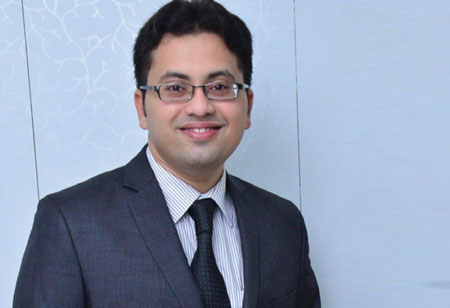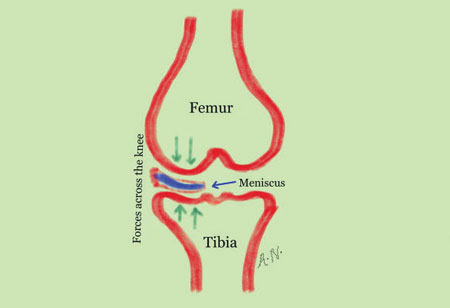
Meniscus Injuries In The Knee And Treatment Options


Dr. Abhishek Arun Nerurkar, Specialist in Shoulder and Knee Surgeries (Arthroscopy and Arthroplasty), Consultant Orthopaedic Surgeon, P.D. Hinduja Hospital, Khar , SL Raheja Fortis, Mahim, Surya Hosp, 0
Knee joint is an extremely complex joint with multiple bony and soft tissue components working together intricately with each other. It is made up of three bones, namely the femur(thigh bone), tibia (calf bone) and patella (knee caps). As the weight of your body passes from the thigh to the calf, the forces across the joint can lead to damage to the joint surfaces. Meniscus (plural menisci) are a pair of fibrocartilage structures within your knee joint that absorb the forces across the bones during weight bearing and high impact activities as well as contact sports.
Menisci are C -shaped structures that are present between your femur and tibia. They are more elastic in nature at birth. However, due to constant forces and age related changes, it starts becoming firm in middle age. Such a degenerate meniscus is prone to tear as it loses its elasticity and gets trapped in between two hard bones. In young individuals meniscus injuries happen as a part of pivoting trauma during sports or as a result of road traffic accidents. They may also happen due to twisting injuries on pavements and staircase. In elderly individuals they may happen with concurrent osteoarthritis, whereas in young they are usually associated with other ligament injuries or as a part of complex internal knee derangement. Proper diagnosis of cause is extremely important to get you the correct choice of treatment.
After thorough clinical evaluation by your doctor, the management usually begins with confirmation of diagnosis with relevant investigations. The most commonly performed tests are the weight bearing X-rays of the involved joint and MRI scans (Magnetic Resonance Imaging). X-rays are needed to check for concurrent bony problems and also to evaluate the joint arthritis. MRI scans will provide you a comprehensive diagnosis about all the soft tissue integrity and thus help in chalking out the management plan to get your knee back to normal. Sometimes, additional investigations like long film Scannogram may be needed to give you information regarding the limb alignment.
As meniscus injuries are diverse in origin, and each meniscus injury may have a different tear pattern, the treatment plan is often individualised on the basis of the clinical evaluation done by your doctor and the assessment of investigations. This is further complicated by the presence of concurrent injuries in cases of trauma, and also presence of arthritis and limb alignment changes that happen in the middle age or elderly patients. In elderly patients, we are now coming across lot of patients with meniscus root tears, which make the meniscus completely functional. These tears need to be assessed carefully and treatment should be done at the earliest to prevent joint damage.
In case of early incomplete tears, or the tears that do not extend to the joint surfaces, the treatment is essentially non surgical. Patients need to understand the probable ways in which the damage may worsen and need to get
lifestyle modifications done on day to day basis. Patients need to undergo a well formulated rehabilitation programme by a trained physioherapist doctor. Strengthening of the quadriceps and hamstring group of muscles is started to improvise the dynamic assistance to the joint function. Exercises like swimming and cycling can be safely performed. Activities like lunges, squats, etc should be avoided. Jogging and running over even and soft surfaces are preferred over working on a treadmill.
However, if the meniscus tears are extending to the joint surface, then it is essential to get the tear sorted by means of a surgical procedure. Meniscus surgeries are performed by a knee hole surgery (Arthroscopy). We insert a scope through a small portal to visualise the complete joint from inside. The image obtained is converted to digital signals and then can be viewed on the monitor. The advantages of arthroscopy are mainly excellent illumination of the joint which is not possible in open surgery, and immense magnification that help in picking up even the smallest of damages to the knee and then treat them accordingly. Nowadays the technology has improved exponentially and we can get upto 4k resolution of the joint.

Once the joint is carefully evaluated, a decision is made on whether it will be beneficial to save the meniscus, or to remove the damaged part. The decision making is very complex as your operating surgeon is the best judge to decide which way to go. According to Dr. Abhishek Nerurkar, Consultant Knee and Shoulder Surgeon, P. D. Hinduja Hospital, Khar, further states that every attempt is made to save the meniscus in young patients, whereas the threshold to removal is low in elderly patients due to poor quality of tissue. Decision is also dependent on the tear pattern. In complex tears, hybrid procedure can be done, where soma part of the meniscus is removed and the critical portion is saved. Decision also depends on whether the tear is in the vascular zone which is more likely to heal, rather than the avascular zone of the meniscus, which has poor healing potential. To sum up, whenever the surgeon feels that the chances of healing are good, then he will repair your meniscus and vice versa. It is also important to treat the concomitant injures and there is a plethora of procedure that may be combined with the meniscus surgery to give your knee the best possible outcome.
According to Dr. Abhishek Nerurkar, Consultant Knee and Shoulder Surgeon, P. D. Hinduja Hospital, Khar, getting treatment at the right time will help you to save your meniscus. The extent of a torn meniscus can increase rapidly with further injuries and reduce the chances of saving the meniscus. Knee pain can happen due to diverse problems, and taking self medications may turn out to be counterproductive. Get yourself evaluated with your Orthopaedic Surgeon to have a long lasting, functional and pain free knee so that you can smile every time you exercise and enjoy your sports and leisure!!!!
According To Dr. Abhishek Nerurkar, Consultant Knee And Shoulder Surgeon, P. D. Hinduja Hospital, Khar, Getting Treatment At The Right Time Will Help You To Save Your Meniscus
However, if the meniscus tears are extending to the joint surface, then it is essential to get the tear sorted by means of a surgical procedure. Meniscus surgeries are performed by a knee hole surgery (Arthroscopy). We insert a scope through a small portal to visualise the complete joint from inside. The image obtained is converted to digital signals and then can be viewed on the monitor. The advantages of arthroscopy are mainly excellent illumination of the joint which is not possible in open surgery, and immense magnification that help in picking up even the smallest of damages to the knee and then treat them accordingly. Nowadays the technology has improved exponentially and we can get upto 4k resolution of the joint.

Once the joint is carefully evaluated, a decision is made on whether it will be beneficial to save the meniscus, or to remove the damaged part. The decision making is very complex as your operating surgeon is the best judge to decide which way to go. According to Dr. Abhishek Nerurkar, Consultant Knee and Shoulder Surgeon, P. D. Hinduja Hospital, Khar, further states that every attempt is made to save the meniscus in young patients, whereas the threshold to removal is low in elderly patients due to poor quality of tissue. Decision is also dependent on the tear pattern. In complex tears, hybrid procedure can be done, where soma part of the meniscus is removed and the critical portion is saved. Decision also depends on whether the tear is in the vascular zone which is more likely to heal, rather than the avascular zone of the meniscus, which has poor healing potential. To sum up, whenever the surgeon feels that the chances of healing are good, then he will repair your meniscus and vice versa. It is also important to treat the concomitant injures and there is a plethora of procedure that may be combined with the meniscus surgery to give your knee the best possible outcome.
According to Dr. Abhishek Nerurkar, Consultant Knee and Shoulder Surgeon, P. D. Hinduja Hospital, Khar, getting treatment at the right time will help you to save your meniscus. The extent of a torn meniscus can increase rapidly with further injuries and reduce the chances of saving the meniscus. Knee pain can happen due to diverse problems, and taking self medications may turn out to be counterproductive. Get yourself evaluated with your Orthopaedic Surgeon to have a long lasting, functional and pain free knee so that you can smile every time you exercise and enjoy your sports and leisure!!!!